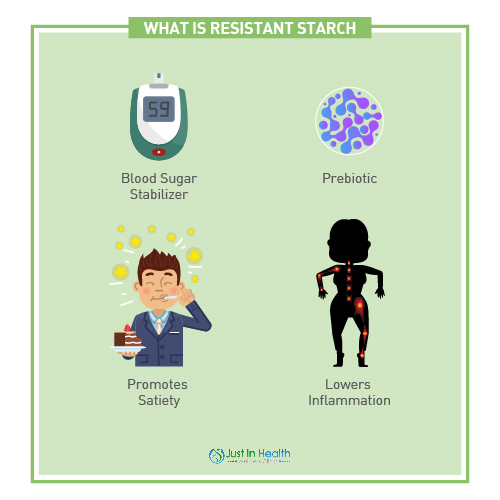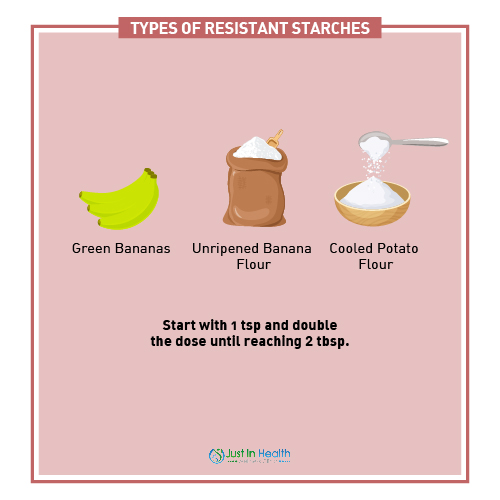

By Dr. Justin Marchegiani

When we hear the word “starch,” a lot of us think of unhealthy carbohydrate-heavy foods. But not all starches are created equally. Resistant starch works differently than processed carbs like pizza and pasta–resistant starch passes through the body without spiking blood sugar without even knocking you out of ketosis!
Resistant starch isn’t completely broken down and absorbed by the body–it passes through undigested which allows you to consume resistant starch without getting thrown out of ketosis and without having blood sugar spikes that come with other starches. Research shows that resistant starch actually stabilizes blood sugar and also acts as a prebiotic to promote healthy gut bacteria.

There are two main sources of resistant starches that I recommend: unripened banana flour, and cooled potato flour. Potato flour is technically a nightshade, which can exacerbate some people’s autoimmune conditions. It’s the alpha-solanine component of the potato that tends to be the problem. If you have an autoimmune condition, try banana flour or plantain flour first. While I personally have used both, I prefer unripened banana flour because I have an autoimmune thyroid condition. Some of my patients do better with the potato flour so you may want to experiment and see which one works best for you.
The goal of using resistant starch is to feed the beneficial bacteria in our small intestine. Many patients that I work with need to do a keto diet or a lower carbohydrate diet to help address and correct blood-sugar imbalances.
Typically, a lower-carbohydrate, higher-fat diet like the keto diet can be a great tool in helping to stabilize the blood sugar. Lowering carb intake also helps take stress off the adrenals/pancreas, thus stabilizing the up and down flows of blood sugar. While this diet can be very beneficial for most people, some research shows that going low-carb can reduce certain good bacteria from our gut population.
Adding resistant starches can help feed and promote the growth of beneficial bacteria in our gut by producing butyric acid—the same fat as butter, essentially. This helps to keep our small intestine more acidic and prevent SIBO (Small Intestinal Bacterial Overgrowth) from coming up from the colon into the small intestine. Butyric acid has also been shown to lower inflammation and fight off cancer cells!
Some people may get a little bit constipated due to the shifts in bacteria on a low-carbohydrate diet. This can be resolved by upping vegetables intake (nonresistant starch polysaccharides) and adding in resistant starch in the two forms mentioned above.
Resistant starch is also used for weight loss as it promotes satiety–which makes you feel fuller for longer–and can prevent cravings. Additionally, further studies have shown that resistant starch can improve insulin sensitivity in subjects with the metabolic syndrome.
Typically, I start with about one teaspoon of resistant starch and work my way up to about two tablespoons. I continue to double my dose until the magic two-tablespoons dosage has been reached. If you have any issues with the resistant starch (excessive gas, bloating, belching, or flatulence), simply cut the dose in half until you find the correct dose for you.
Resistant starch can be used as a diagnostic tool to assess if you may potentially have SIBO (small intestinal bacterial overgrowth).
SIBO is when the bacteria from our large intestine is moving back up to the small intestine. If you take a little bit of resistant starch and have any exacerbation of symptoms, like bloating, gas, bent-over pain, or excessive flatulence–that’s a sign that you more than likely have SIBO.
SIBO can be diagnosed with expensive lab testing, which sometimes may be needed—but I recommend trying resistant starches first to see how they work for you.
The goal of resistant starch is to act like a prebiotic which feeds the beneficial bacteria in your gut while increasing butyrate. The elevated levels of butyrate also make the gut environment more inhospitable, essentially creating a better environment for good bacteria to live in and a very inhospitable environment for bad bacteria to live in.
For some people with SIBO and other more serious gut issues, you may need to do more than just use resistant starch. We would start by looking for any infections and pathogens in the gut which need to be removed first.
Are you are having chronic gut issues (leaky gut syndrome), fatigue, low thyroid symptoms, and weight gain?
If you are looking to get some answers, running some specific functional medicine tests may be the only way. Most chronic health issues tend to get worse over time if they are left untreated, and the conventional medical options tend to cause more problems in the long run.
References:
https://onlinelibrary.wiley.com/doi/abs/10.1111/j.1464-5491.2010.02923.x